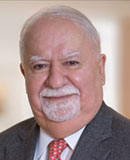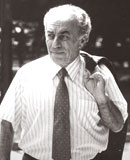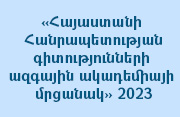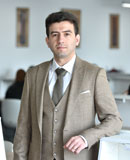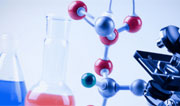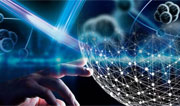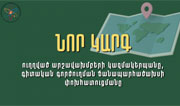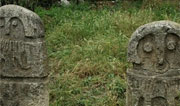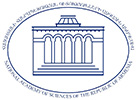 |
|||||||||||||||
|
|||||||||||||||
| Գլխավոր էջ | Ակադեմիայի մասին | Բաժանմունքներ | Կազմակերպություններ | Անդամներ | Կապ մեզ հետ |
|
|
|
 ՀՀ ԳԱԱ գիտության զարգացման հիմնադրամ  Հայագիտական ուսումնասիրությունները ֆինանսավորող համահայկական հիմնադրամ 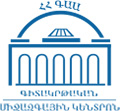 ՀՀ ԳԱԱ գիտակրթական միջազգային կենտրոն  ՀՀ ԳԱԱ հիմնարար գիտական գրադարան  Վիկտոր Համբարձումյանի անվան մրցանակի շնորհման միջազգային կոմիտե  Հայկական ազգային տեղեկատվական կետ HORIZON 2020  EURAXESS-Armenia Portal   Հայաստանի ակադեմիական գիտահետազոտական կոմպյուտերային ցանց |
Նորություններ / Պահոց
|
Ազդեր
2024թ.-ի ապրիլի 23-ին՝ ժամը 10:30-ին, ՀՀ Գիտությունների ազգային ակադեմիայում տեղի կունենա տարեկան ընդհանուր ժողով՝ նվիրված ՀՀ ԳԱԱ 2023թ.-ի գիտական և գիտակազմակերպական գործունեության հիմնական արդյունքներին: Գիտությունների բաժանմունքների տարեկան ընդհանուր ժողովները կանցկացվեն ապրիլի 22-ին՝ ժամը 10:00-ին ՀՀ ԳԱԱ ՖՀԻ-ը IPR Armenia Optica Student Chapter-ի հետ միասին հայտարարում են «Լույսը լուսանկարչի աչքերով» խորագրով ֆոտոմրցույթ՝ նվիրված Լույսի միջազգային օրվան: Մրցույթին գրացման վերջնաժամկետն է՝ ս.թ. մայիսի 1-ը Ս.թ. ապրիլի 10-ին ժ. 15:00-ին ՀՀ ԳԱԱ նիստերի դահլիճում (Բաղրամյան պող., 24) տեղի կունենա սեմինարների շարքի երրորդ հանդիպումը՝ «Հավաքում ենք փաթիլ. ատոմներից դեպի մոլեկուլ և բյուրեղ» խորագրով: Որպես մոդերատոր հանդես կգա անվանի քիմիկոս, SKOLKOVO-ի գիտության և տեխնոլոգիաների ինստիտուտի պրոֆեսոր Արտեմ Օհանովը Ս.թ. ապրիլի 1-ին, ժամը 12:00-ին ՀՀ ԳԱԱ Նախագահության նիստերի դահլիճում տեղի կունենա «Մագնիսաչափությունը՝ միջուկային սպին-բևեռացված 14N-ով ադամանդում NV-կենտրոնների հիման վրա» թեմայով սեմինար, որը կներկայացնի Լատվիայի համալսարանի պրոֆեսոր Մարցիս Աուզինշը ՀՀ ԳԱԱ Շիրակի հայագիտական հետազոտությունների կենտրոնը սկսում է «Գիտական աշխատություններ» պարբերականի 2024թ.1 (27) հատորի հոդվածների ընդունումը: Առաջնահերթությունը տրվում է անգլերեն և ռուսերեն լեզուներով հոդվածներին: Հոդվածների ընդունման վերջնաժամկետն է՝ 2024թ. մարտի 1-ը Международный инновационный центр нанотехнологий СНГ (МИЦНТ СНГ) при поддержке Межгосударственного фонда гуманитарного сотрудничества государств - участников СНГ (МФГС) и Объединенного института ядерных исследований объявляет о проведении конкурса на соискание грантов на разработку проектов в рамках деятельности МИЦНТ СНГ в 2024 году и очередной Стажировки молодых ученых и специалистов стран СНГ в Дубне в апреле - мае 2024года ՀՀ գիտության և տեխնիկայի զարգացման 2020-2024թթ. գերակայության ՀՀ կառավարության որոշման նախագիծ Հրապարակումներ մամուլում
Կայքը հաճախել են
6 953 260 անգամ սկսած 01.01.2005թ.  ՀՀ ԳԱԱ պատկերանիշ (սև, կապույտ) |
 |
Կայքը վերջին անգամ թարմացվել է՝ 15:46, 19/04/2024 |  |
|
Գլխավոր էջ -
Ակադեմիայի մասին -
Բաժանմունքներ -
Կազմակերպություններ -
Անդամներ -
Կապ մեզ հետ -
Կառուցվածք -
COVID-19
|
|||||
|
© Copyright 1998-2024 Բոլոր հեղինակային իրավունքները պաշտպանված են: Կայքը պատրաստված է և սպասարկվում է Հայաստանի ակադեմիական գիտահետազոտական կոմպյուտերային ցանցի կողմից (ASNET-AM): Հարցերի կամ առաջարկությունների համար կարող եք ուղարկել նամակ webmaster {[ at ]} sci.am էլեկտրոնային փոստին: |

![academy [@] sci.am academy [@] sci.am](images/email.jpg)








